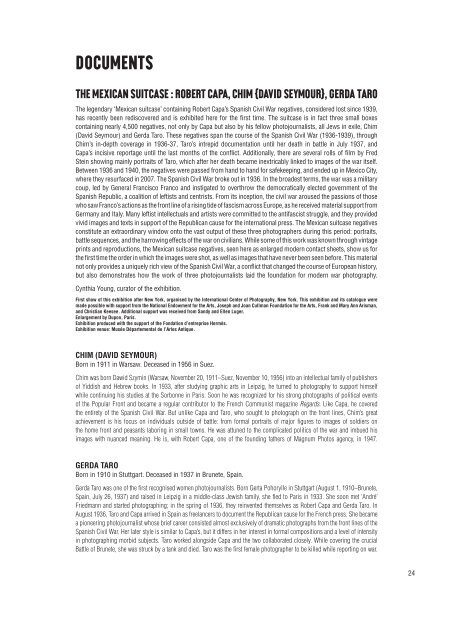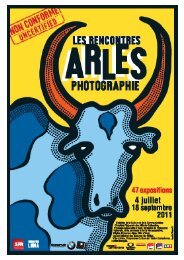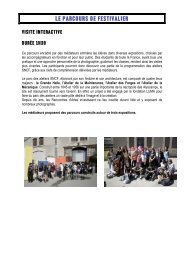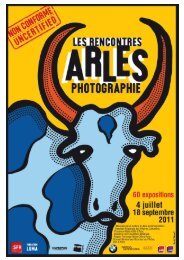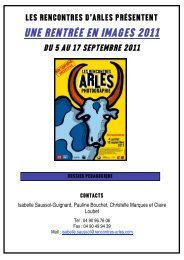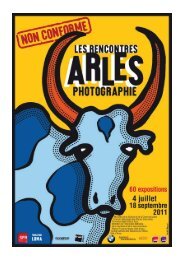Download - Les Rencontres d'Arles
Download - Les Rencontres d'Arles
Download - Les Rencontres d'Arles
You also want an ePaper? Increase the reach of your titles
YUMPU automatically turns print PDFs into web optimized ePapers that Google loves.
DOCUMENTS<br />
THE MEXICAN SUITCASE : ROBERT CAPA, CHIM (DAVID SEYMOUR), GERDA TARO<br />
The legendary ‘Mexican suitcase’ containing Robert Capa’s Spanish Civil War negatives, considered lost since 1939,<br />
has recently been rediscovered and is exhibited here for the first time. The suitcase is in fact three small boxes<br />
containing nearly 4,500 negatives, not only by Capa but also by his fellow photojournalists, all Jews in exile, Chim<br />
(David Seymour) and Gerda Taro. These negatives span the course of the Spanish Civil War (1936-1939), through<br />
Chim’s in-depth coverage in 1936-37, Taro’s intrepid documentation until her death in battle in July 1937, and<br />
Capa’s incisive reportage until the last months of the conflict. Additionally, there are several rolls of film by Fred<br />
Stein showing mainly portraits of Taro, which after her death became inextricably linked to images of the war itself.<br />
Between 1936 and 1940, the negatives were passed from hand to hand for safekeeping, and ended up in Mexico City,<br />
where they resurfaced in 2007. The Spanish Civil War broke out in 1936. In the broadest terms, the war was a military<br />
coup, led by General Francisco Franco and instigated to overthrow the democratically elected government of the<br />
Spanish Republic, a coalition of leftists and centrists. From its inception, the civil war aroused the passions of those<br />
who saw Franco’s actions as the front line of a rising tide of fascism across Europe, as he received material support from<br />
Germany and Italy. Many leftist intellectuals and artists were committed to the antifascist struggle, and they provided<br />
vivid images and texts in support of the Republican cause for the international press. The Mexican suitcase negatives<br />
constitute an extraordinary window onto the vast output of these three photographers during this period: portraits,<br />
battle sequences, and the harrowing effects of the war on civilians. While some of this work was known through vintage<br />
prints and reproductions, the Mexican suitcase negatives, seen here as enlarged modern contact sheets, show us for<br />
the first time the order in which the images were shot, as well as images that have never been seen before. This material<br />
not only provides a uniquely rich view of the Spanish Civil War, a conflict that changed the course of European history,<br />
but also demonstrates how the work of three photojournalists laid the foundation for modern war photography.<br />
Cynthia Young, curator of the exhibition.<br />
First show of this exhibition after New York, organised by the International Center of Photography, New York. This exhibition and its catalogue were<br />
made possible with support from the National Endowment for the Arts, Joseph and Joan Cullman Foundation for the Arts, Frank and Mary Ann Arisman,<br />
and Christian Keesee. Additional support was received from Sandy and Ellen Luger.<br />
Enlargement by Dupon, Paris.<br />
Exhibition produced with the support of the Fondation d’entreprise Hermès.<br />
Exhibition venue: Musée Départemental de l’Arles Antique.<br />
CHIM (DAVID SEYMOUR)<br />
Born in 1911 in Warsaw. Deceased in 1956 in Suez.<br />
Chim was born Dawid Szymin (Warsaw, November 20, 1911–Suez, November 10, 1956) into an intellectual family of publishers<br />
of Yiddish and Hebrew books. In 1933, after studying graphic arts in Leipzig, he turned to photography to support himself<br />
while continuing his studies at the Sorbonne in Paris. Soon he was recognized for his strong photographs of political events<br />
of the Popular Front and became a regular contributor to the French Communist magazine Regards. Like Capa, he covered<br />
the entirety of the Spanish Civil War. But unlike Capa and Taro, who sought to photograph on the front lines, Chim’s great<br />
achievement is his focus on individuals outside of battle: from formal portraits of major figures to images of soldiers on<br />
the home front and peasants laboring in small towns. He was attuned to the complicated politics of the war and imbued his<br />
images with nuanced meaning. He is, with Robert Capa, one of the founding fathers of Magnum Photos agency, in 1947.<br />
GERDA TARO<br />
Born in 1910 in Stuttgart. Deceased in 1937 in Brunete, Spain.<br />
Gerda Taro was one of the first recognised women photo journalists. Born Gerta Pohorylle in Stuttgart (August 1, 1910–Brunete,<br />
Spain, July 26, 1937) and raised in Leipzig in a middle-class Jewish family, she fled to Paris in 1933. She soon met ‘André’<br />
Friedmann and started photo graphing; in the spring of 1936, they reinvented themselves as Robert Capa and Gerda Taro. In<br />
August 1936, Taro and Capa arrived in Spain as freelancers to document the Republican cause for the French press. She became<br />
a pioneering photojournalist whose brief career consisted almost exclusively of dramatic photographs from the front lines of the<br />
Spanish Civil War. Her later style is similar to Capa’s, but it differs in her interest in formal compositions and a level of intensity<br />
in photographing morbid subjects. Taro worked alongside Capa and the two collaborated closely. While covering the crucial<br />
Battle of Brunete, she was struck by a tank and died. Taro was the first female photographer to be killed while reporting on war.<br />
24


